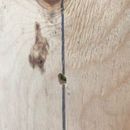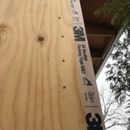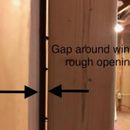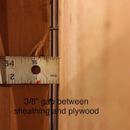New plywood sheathing needs fix?
I’m working on exterior improvements during a complete remodel on my 1968 house in CZ 6A near Minneapolis, and I have concerns with the quality of work the exterior crew has done.
The original stucco and 3/4″ fiberboard was removed, and I’m trying to air seal the new 3/4″ plywood sheathing best I can with taped seams. While installing the new sheathing, the crew was quickly slamming up the sheets tight together even though it says directly on it to leave a 1/8″ gap. They said it was fine without a gap, but they did run a kerf between sheets after it was installed. Now the sheathing is complete and I’ve noticed:
1. Overdriven nails:
Almost every 2″ (6d) ring shank nail was overdriven by +1/8″. They explained this was normal with the framing nail gun, and it wouldn’t drive the nails far enough into the studs if dialed back.
2. Gaps between studs and sheathing:
The plywood is tight to the studs along the edges, but there many large gaps up to 3/8″ between the studs in the middle of the plywood. I was told this would be tight after nailing the field, but after nailing these gaps still remain. Some of these gaps are around the edges of the window rough openings.
3. Missed nails into studs:
17 studs had 4 or more nails that missed for a total of 125, and none of those sections were re-nailed. A few had more than 10 on a single stud. This was only for 110′ linear feet of wall sections 8′ high.
4. Misaligned edge of plywood and stud:
They vertically misaligned one sheet with the studs so badly that the bottom 1/2 was unable to be nailed on edge because there wasn’t enough plywood overlapping the stud.
I’ve attached a few photos as a reference. Their excuse is that the 3/4″ plywood is difficult to work with. I think failing to align the plywood and nail it properly is what caused these problems. To make it even worse, these guys already installed most of the house wrap…which also has installation defects. At a minimum, I feel the areas with missed nails need to be re-fastened.
Should I try to get the plywood tight to the studs to improve the air sealing within each stud bay?
Am I being overly picky about these issues or is this low quality work?
Also, this is the same crew scheduled to install the new windows, and right now I don’t have a lot of confidence they can do that correctly.
GBA Detail Library
A collection of one thousand construction details organized by climate and house part














Replies
Hi Kris,
I'll let the experienced builders comment on the quality of the work...
My initial reaction is that I wouldn't worry too much about the over driven nails given that the plywood is 3/4" thick. (A nail over-driven by 1/8" in 3/4" sheathing is the same as a flush nail driven into 5/8" sheathing. (Even though over driven nails can be a code violation.)
You can fix the other issues with a small box of GRK screws and an impact driver in about 30 minutes.
I wouldn't lose too much sleep over it.
Hey Rick,
Thanks for the tip about using the screws. I'll give it a try!
Kris,
I general I think Rick is right but let's go though each of them to address your concerns.
1. You framer's explanation is self-serving. What they don't want are the occasional proud nail-head they would have to hand sink, so they set their gun higher than they should. Unfortunately the holding power of nails that are over-sunk isn't directly proportional with amount of plywood that remains. Breaking the surface appreciably weakens it. However, unless you are in a high-seismic area, it usually doesn't make much difference.
2. This matters - mainly because it changes the wall thickness in spots making air-sealing and installing trim a lot harder, but also because it significantly affects the shear resistance of the sheathing. A half hour with a framing hammer will correct the problem - or as Rick suggests, you can suck things together with some screws, although you still need to sink the nail heads.
3. Porcupines, as my friend Derick calls them , represent a code violation, as the fastening schedule hasn't been followed. It's one thing to miss and leave the nails but add more, it's another to not correct the error at all.
4. If you don't have a nailing surface, you need to add blocking. No ifs or buts.
As Rick said, the remediation required doesn't amount to much. Whether you do it yourself or get the builder to is your call. It does speak to their level of workmanship and also to their standards as to what they think is acceptable - and that is worrying if you are considering having them do tasks that require an attention to detail.
Great info Malcolm! I had no idea about the over driven nails.
Rick,
To be clear, the reduction in pull-through strength is linear and corresponds to the depth of the panel remaining, but the damage to the area around the nail-head when any over-driving occurs (especially in wood and OSB, and especially at the edges), is what reduces the strength beyond what you would expect given the proportion.
Hi Malcolm,
Thank you for the detailed response. It's very helpful to get a neutral perspective from someone in the building industry, and I feel a little better knowing I'm justified in requiring these items get fixed.
I agree with you that it is worrying if they are making these types of errors.
Kris,
Good luck with the rest of your project!
I’d be really nervous with those guys doing the window installs. Putting up plywood sheathing is mostly just grunt work. Put a panel up, nail it a bunch of times in straight lines, pretty basic stuff. Putting in windows requires a LOT more attention to detail, and if they mess up flashing details you can have lots of problems, sometimes hidden problems, down the road.
Bill
When all that was involved was slapping the windows in and nailing off the flanges, it made sense to have the framer's do it. But we have seen what that lead to, and the improved details that have evolved to improve both air-sealing and water intrusion aren't a go0d fit for the skills that make for successful framers. Someone else needs to start doing that work.